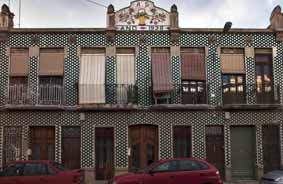
The Universitat de València’s committee for the study of Cabanyal-Canyamelar neighbourhood proposes a comprehensive socioeconomic plan (Plan Integral Socioeconómico), which should be considered from a ‘multidisciplinary approach’ and which should include ‘citizens’ involvement as a vital link in its drafting.’ This proposal is part of the university committee’s report, which was analysed by the Governing Council last Wednesday, February the 1st.
The report was presented by the committee’s president, the Vice-principal for Participation and Territorial Projection, Jorge Hermosilla. As the data included in the document states, Cabanyal-Canyamelar neighbourhood is in demographic decline, since in the last 40 years the population has decreased by 35%. Its residents are also ageing (the ageing index is 150 whereas this index is 121,7 for the whole city of Valencia) and the traditional jobs related to fishing and the seaport have been left behind. Its population is deeply rooted to the neighbourhood and to the city because most of they are born in the city or in the same neighbourhood.
According to the report, ‘the local residents in Cabanyal-Canyamelar neighbourhood are currently suffering an internal division. Some interviewed people said that they are suffering an identity crisis due to the desertion of the traditional activities carried out and to the construction of the Paseo del Mar, an additional seafront to be constructed, which will directly affect Cabanyal neighbourhood.’ Then, it is stated that the extension project of the seaport Paseo del Mar has created an internal division among the locals because of diverse reasons: buildings’ demolitions, business opportunities, inhabited houses and their illegal occupation, etc. So the social unrest is evident.’
The committee explained that ‘the extension project has not been either a socioeconomic or an urban development incentive up to the moment for the neighbourhood, since the construction is in stand by for some years. PEPRI approval and the long judiciary controversy have ended being a hindrance for the neighbourhood urban regeneration.’
The experts concluded that ‘from a social and economic point of view, there is neither a global design for the neighbourhood nor a common project between the two parties.’ ‘It is evident that one of the consequences of the current situation of Cabanyal-Canyamelar neighbourhood is landscape degradation and the perception of neglect.’
The comprehensive socioeconomic plan (Plan Integral Socioeconómico) should solve the declining process of the houses through programmes allowing people to leave the houses taken up illegally. It also should include programmes to attract new residents. Actions to renovate the neighbourhood’ premises should be carried out as well.
Mitigation of social unrest among the residents in the last years is considered a crucial element.
The Universitat de València’s contribution, according to the report, should focus on some actions. For example, the conduction of specialized studies which would be implemented by researchers of different disciplines, and the creation of joint programmes and actions from the public universities.
The report guarantees that the actions the Universitat de València could implement in the neighbourhood are:
‘1. Technical advice by the departments and university institutes, specially to the persons in charge of the decision making.
2. Technical collaboration with the different professionals working in the neighbourhood. It would be useful to make public calls related to R&D&I fields.
3. Supporting the initiatives of the creation of university halls of residence, which would revitalize the neighbourhood immediately. The great amount of students studying in the public universities (including the Erasmus students) is a good reason to create collaboration formulas with the neighbourhood local companies. There are many possibilities.
4. Organizing workshops, seminars, exhibitions aimed at the social and cultural promotion and dynamization of the neighbourhood. It would be enough with the coordination of actions from the Universitat and the designing of a joint programme with the local agents.
5. Creation of a museum project taking advantage of the cultural, artistic and architectonic legacy would be very useful. The creation of an open museum would boost the neighbourhood favouring its discovering, adding it value and differentiation from others.
Nowadays, around 646 university students and 43 lecturers live in the neighbourhood, the report states.
Some members of the Governing Council have congratulated the experts on their work with the committee and have asked for specific investment in the neighbourhood.
Institutional condolences
In his report, the Principal, Esteban Morcillo, expressed his condolences for the deaths of the lecturer of medicine Antonio Sabater Pons and the head of the research support unit, Vicent Balbastre. They were, as the Principal stated, two well considered persons in the institution.
The approval of a protocol against sexual harassment was put off until next Governing Council meeting.
Last update: 3 de february de 2012 08:58.
News release



















